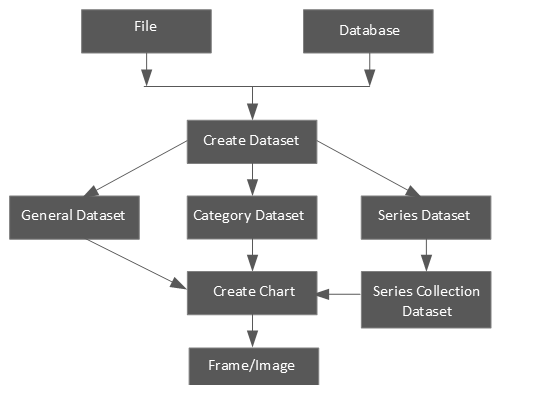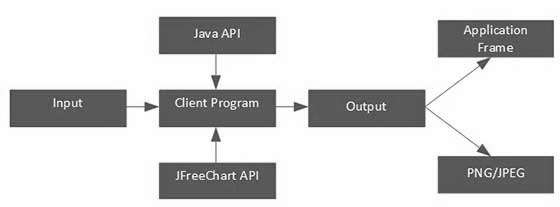This chapter explains basic class level and application level
architectures of JFreeChart to give you an idea about how JFreeChart
interacts with different classes and how it fits in your Java based
application.
Class Level Architecture
The class level architecture explains how various classes from the
library interacts with each other to create various types of charts.

Following is the detail of the units used in the above block diagram :
| Units |
Description |
| File |
The source having user input to be used for creating a dataset in the file. |
| Database |
The source having user input to be used for creating a dataset in the database. |
| Create Dataset |
Accepts the dataset and stores the dataset into dataset object. |
| General Dataset |
This type of dataset is mainly used for pie charts. |
| Category Dataset |
This type of dataset is used for bar chart, line chart,etc. |
| Series Dataset |
This type of dataset is used for storing series of data and construct line charts. |
| Series Collection Dataset |
The different categories of series datasets are added to series
collection dataset. This type of dataset is used for XYLine Charts. |
| Create Chart |
This is the method which is executed to create final chart. |
| Frame/Image |
The chart is displayed on a Swing Frame or an image is created. |
Application Level Architecture
The application level architecture explains where JFreeChart library sits inside a Java Application.

The client program receives user data and then it make use standard
Java and JFreeChart APIs based on requirements to generate the output in
the form of either a frame, which can be displayed directly inside the
application or independently in the image formats such as JPEG or PNG.
 Following is the detail of the units used in the above block diagram :
Following is the detail of the units used in the above block diagram : The client program receives user data and then it make use standard
Java and JFreeChart APIs based on requirements to generate the output in
the form of either a frame, which can be displayed directly inside the
application or independently in the image formats such as JPEG or PNG.
The client program receives user data and then it make use standard
Java and JFreeChart APIs based on requirements to generate the output in
the form of either a frame, which can be displayed directly inside the
application or independently in the image formats such as JPEG or PNG. Following is the detail of the units used in the above block diagram :
Following is the detail of the units used in the above block diagram : The client program receives user data and then it make use standard
Java and JFreeChart APIs based on requirements to generate the output in
the form of either a frame, which can be displayed directly inside the
application or independently in the image formats such as JPEG or PNG.
The client program receives user data and then it make use standard
Java and JFreeChart APIs based on requirements to generate the output in
the form of either a frame, which can be displayed directly inside the
application or independently in the image formats such as JPEG or PNG.
No comments:
Post a Comment